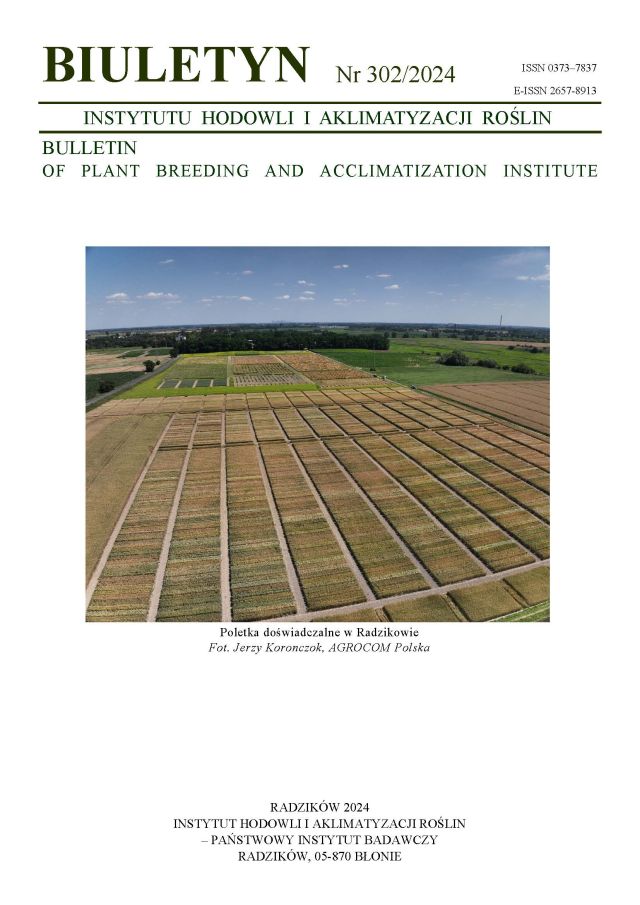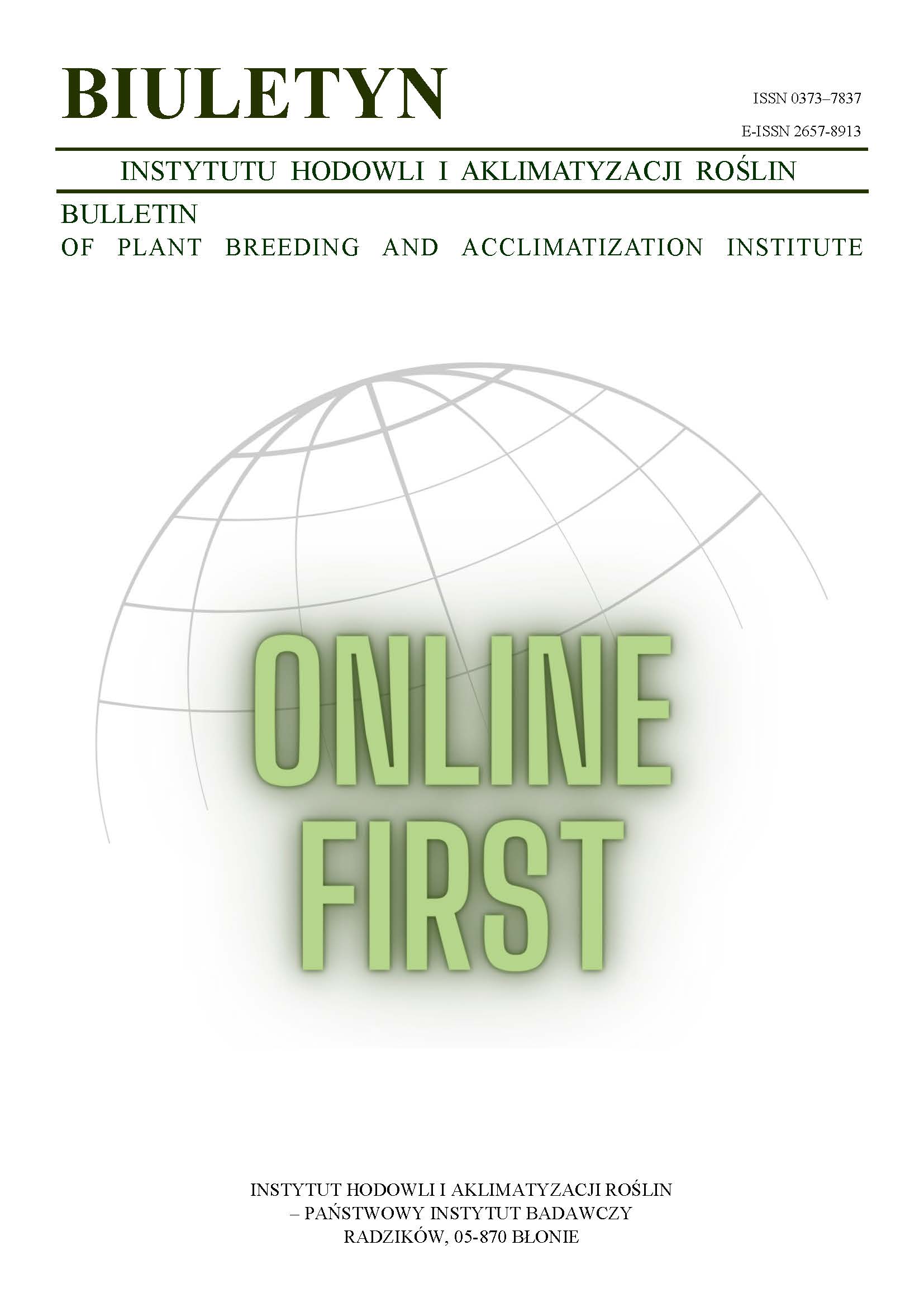An attempt at application of the rye Pampa cytoplasm in hybrid breeding of triticale
Bogusław Łapiński
b.lapinski@ihar.edu.plKrajowe Centrum Roślinnych Zasobów Genowych, Instytut Hodowli i Aklimatyzacji Roślin, Radzików (Poland)
Abstract
Crosses between diploid rye with male-sterilizing Pampa cytoplasm and winter triticale were performed in the years 2000 and 2001. Both tetraploids and hexaploids of triticale proved to be successful as male parents in production of the F1 hybrids. Back-crossing of the hybrids caused transfer of the Pampa cytoplasm into tetraploid and hexaploid triticale. In 2002, female fertility of the plant material was high enough to start selection of male sterile lines as well as of those with restored male fertility. The results for pollen shed from the year 2004 showed a full range of variation, from complete sterility to full fertility. The sterilizing effect of the Pampa cytoplasm was stronger in tetra- than in hexaploid triticale. Among the tetraploids, eight of 14 lines brought full sterility to all investigated B1F1 generation hybrids. Among the hexaploids, only two of 20 lines caused a similar effect. However, selection progress in fertility restoration was only observed in the tetraploids. An increase in vegetative vigour in Pampa-cytoplasmic F1 was only found in the tetraploid group. Among the hexaploids, the vigour was distinctly diminished in the majority of genotypes, compared to the male parents and F1 with another rye cytoplasm.
Keywords:
CMS, hexaploid triticale, hybrid breeding, Pampa cytoplasm, tetraploid triticaleReferences
Burger H., Oettler G., Melchinger A. E. 2002. Heterosis and combining ability for grain yield and yield components in winter triticale. Proc. 5th Int. Triticale Symp., Radzików, Poland, Vol. 1: 199-204.
Google Scholar
Darvey N. L., Roake J. 2002. Development of spring hybrid triticale. Proc. 5th Int. Triticale Symp. June 30 July 5. 2002, Radzików, Poland. Vol. 1: 207 — 209.
Google Scholar
Gordei I. A., Belko N. B., Khokhlova S. A., Lyusikov O. M., Hainudzinau A. V. 2002. Development of genetic triticale diversity with rye cytoplasm. Proc. 5th Int. Triticale Symp. Radzików, Poland, June 30 July 5, 2002. Vol. I: 53 — 62
Google Scholar
Krolow K. D. 1973. Research work with 4x-Triticale in Germany (Berlin). In: Proceedings of the international Triticale symposium, El Batan, Mexico, 1–3 October 1973. Int. Develop. Res. Centre Monogr. IDRC – 024e.
Google Scholar
Góral H. 2002. Biologiczno-hodowlane aspekty wykorzystania heterozji u pszenżyta (X Triticosecale Wittmack). Zeszyty Nauk. Akad. Rol. im. H. Kołłątaja w Krakowie. Rozprawy. Zeszyt 283.
Google Scholar
Góral H., Spiss L. 2005. Hodowla dopełniaczy i restorerów dla systemu cms-T. timopheevi u pszenżyta jarego. Biul. IHAR 236: 1 — 6.
Google Scholar
Łapiński B., Apolinarska B., Budzianowski G., Cyran M., Rakowska M. 1996. An attempt at tetraploid triticale improvement. In: H. Guedes-Pinto et al. (eds.), Triticale: today and tomorrow. Kluwer Acad. Publ., Dordrecht: 627 — 634.
DOI: https://doi.org/10.1007/978-94-009-0329-6_81
Google Scholar
Łapiński B., Schwarzacher T. 2000. Odblokowanie ekspresji niektórych genów żyta w pszenżycie tetraploidalnym w wyniku translokacji homeologicznej. Biul. IHAR 211: 211 — 218.
Google Scholar
Łapiński B. 2002. A new source of earliness in tetraploid Secalotriticum. Proc. 5th Int. Triticale Symp. Radzików, Poland, June 30 July 5, 2002. Vol. II: 49 — 53.
Google Scholar
Murashige T., Skoog F. 1962. A revised medium for a rapid growth and bioassay with tobacco tissue cultures. Physiol. Plant. 15: 473.
DOI: https://doi.org/10.1111/j.1399-3054.1962.tb08052.x
Google Scholar
Oettler G., Becker H. C., Hoppe G. 2001. Heterosis for yield and other agronomic traits of winter triticale F1 and F2 hybrids. Plant Breed. 120: 351 — 353.
DOI: https://doi.org/10.1046/j.1439-0523.2001.00624.x
Google Scholar
Pfeiffer W. H., Sayre K. D., Mergoum M., van Beem J. 1997. Heterosis in spring triticale hybrids. Book of Abstracts: The Genetics and Exploitation of Heterosis in Crops. 17–22 Aug. 1997, Mexico City: 2 — 6.
Google Scholar
Warzecha R., Salak-Warzecha K. 2002. Hybrid triticale-prospects for research and breeding. Part II: Development of male sterile lines. Proc. 5th Int. Triticale Symp., Radzików, Poland, Vol.1: 193 — 198.
Google Scholar
Authors
Bogusław Łapińskib.lapinski@ihar.edu.pl
Krajowe Centrum Roślinnych Zasobów Genowych, Instytut Hodowli i Aklimatyzacji Roślin, Radzików Poland
Statistics
Abstract views: 67PDF downloads: 29
License
Copyright (c) 2005 Bogusław Łapiński

This work is licensed under a Creative Commons Attribution-ShareAlike 4.0 International License.
Upon submitting the article, the Authors grant the Publisher a non-exclusive and free license to use the article for an indefinite period of time throughout the world in the following fields of use:
- Production and reproduction of copies of the article using a specific technique, including printing and digital technology.
- Placing on the market, lending or renting the original or copies of the article.
- Public performance, exhibition, display, reproduction, broadcasting and re-broadcasting, as well as making the article publicly available in such a way that everyone can access it at a place and time of their choice.
- Including the article in a collective work.
- Uploading an article in electronic form to electronic platforms or otherwise introducing an article in electronic form to the Internet or other network.
- Dissemination of the article in electronic form on the Internet or other network, in collective work as well as independently.
- Making the article available in an electronic version in such a way that everyone can access it at a place and time of their choice, in particular via the Internet.
Authors by sending a request for publication:
- They consent to the publication of the article in the journal,
- They agree to give the publication a DOI (Digital Object Identifier),
- They undertake to comply with the publishing house's code of ethics in accordance with the guidelines of the Committee on Publication Ethics (COPE), (http://ihar.edu.pl/biblioteka_i_wydawnictwa.php),
- They consent to the articles being made available in electronic form under the CC BY-SA 4.0 license, in open access,
- They agree to send article metadata to commercial and non-commercial journal indexing databases.
Most read articles by the same author(s)
- Teresa Oracka, Zbigniew Rybka , Bogusław Łapiński , The influence of homoeologous D(A) and D(B) substitutions on plant dry matter, nitrogen and phosphorus accumulation and utilization efficiency in hexaploid triticale young plants grown in hydroponics , Bulletin of Plant Breeding and Acclimatization Institute: No. 288 (2020): Regular issue
- Bogusław Łapiński, Jacek Matusiak, Assessment of new materials for hybrid breeding of winter triticale with rye cytoplasm of the Pampa type , Bulletin of Plant Breeding and Acclimatization Institute: No. 260/261 (2011): Regular issue
- Bogusław Łapiński, Zygmunt Nita, Aleksandra Szołkowska, Patrycja Wieczorek, A hybrid of cultivated oat with the wild species Avena macrostachya as a source of new variation for yield quality improvement in naked oats , Bulletin of Plant Breeding and Acclimatization Institute: No. 270 (2013): Regular issue
- Bogusław Łapiński, Oat in interspecific crosses , Bulletin of Plant Breeding and Acclimatization Institute: No. 283 (2018): Special issue
- Bogusław Łapiński, Anomalous restoration of parental karyotypes in F2 progeny of some crosses between tetraploid triticale and tetraploid rye , Bulletin of Plant Breeding and Acclimatization Institute: No. 228 (2003): Regular issue














